Brief Answer: The average monthly electric bill for San Diego is $292 - $418 when the power consumption is 836kWh per month and the electric rate lies between $0.35 and $0.50 per kWh.
On average, San Diego residents spend about $292 - $418 per month on electricity bills. That's much higher than a nationwide monthly electric bill of $157, where the average electric rate is 17.47 cents per kWh and power consumption lies around 899kWh. However, the exact electric bill you pay will depend on the utility company and their electric rates.
Thankfully, there are ways to lower the electric bill. One of the best ways to wave it off is to invest in solar generators. Jackery Solar Generators is one of the best solar generators in terms of credibility, reliability, and efficiency. It’s portable, easy, and quick to charge, and the best models can power up heavy equipment like refrigerators, air conditioners, and others.
AI Takeaways
- The average electric rate in San Diego is approximately 39-42¢ per kWh, significantly above both the California and national averages.
- The typical residential usage in San Diego is about 836 kWh per month, leading to the high monthly bills despite moderate consumption.
- San Diego households spend, on average, around $250-$400 per month on electricity.
- Why is your electricity bill so high in San Diego.
- How much does it cost to live in San Diego.
What Is The Average Electric Bill in San Diego?
The average electric bill in San Diego is around $351.12 per month, with the state’s average electric rate per kWh standing at 41.7 cents (December 2024 data). It is much higher than the average electric rate in California, which stands at 35.03 cents per kWh (May 2025 data from EIA).
San Diego is a small coastal state with not a very high population, and the investor-owned utility, SDG&E, swaths its costs on them. Besides, energy consumption soars during extreme weather conditions. A study by the University of San Diego shows that people in coastal areas (like San Diego) typically consume 124% more electricity during summers (using ACs and refrigerators), which, going by the typical estimate, takes the electricity bill to $236. That’s the opposite during winters when most Californians use natural gas-powered heaters to combat the weather and there’s a spike in the price of natural gas.
Not only consumption but also price changes under time-of-use plans are typical reasons behind higher monthly bills. During on-peak hours, the rate per kWh stands at 65.87 cents in summer compared to 41.4 cents in winter. That reflects heavily on your monthly electric bills.
Have San Diego Electric Bills Changed These Years?
San Diego's electric bills have changed over the years. The electric prices have been relatively high for many years, but the rise has been rapid since 2020. According to a US BLS (Bureau of Labor Statistics) report, the electric rate has risen from 27.0 cents per kWh in December 2018 to 42.0 cents in December 2024, a significant increase in the last few years.
The chart below shows the average recorded rates from 2018 to 2023, as per BLS, alongside the forecasted rates by CPUC in their published Senate Bill 695 report.
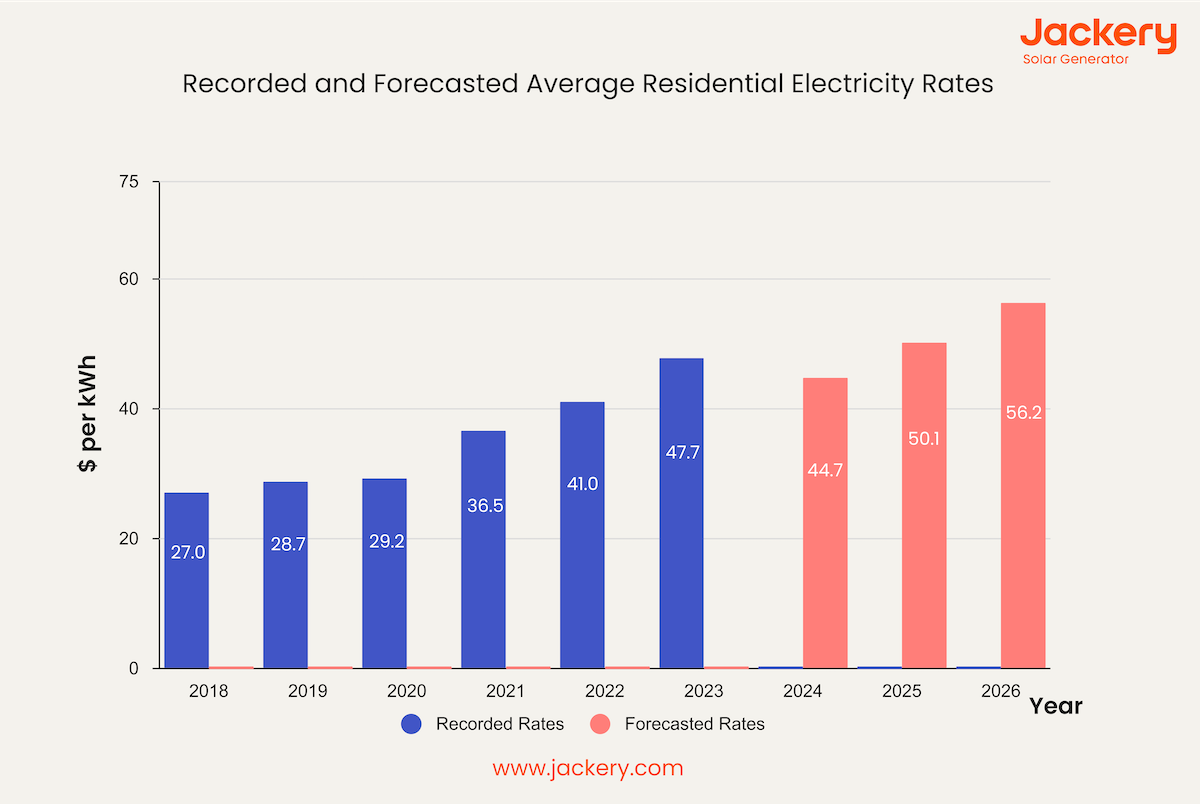
Source: BLS and CPUC
While all forecasts are subject to change, it’s worth noting that the forecasts made in the Senate Bill report are lower than what BLS has recorded so far, probably due to their difference in data collection methods.
The Senate bill forecasts that SDG&E will probably charge 39% more from its customers in 2026, with an annual increase of 10.4%. If you go by the recorded rates by BLS, you can expect the rate to stand at 64 cents per kWh. That takes the average electric bill in San Diego to $320, considering the consumption stays the same.
Irrespective, the bottom line here is that SDG&E already charges the highest electric rates in the nation, and they will keep climbing. Now, let’s look into how the rates in San Diego compare to other states. Here’s a table of comparison:
|
City / State |
Avg. Monthly Electric Bill |
Avg. Electricity Price |
Avg. Monthly Usage |
|
San Diego |
$351.12 |
42.0 ¢ per kWh |
836 kWh |
|
Hawaii |
$206.38 |
44.03 ¢ per kWh |
503 kWh |
|
Texas |
$177.52 |
15.49 ¢ per kWh |
1146 kWh |
|
Illinois |
$124.57 |
18.62 ¢ per kWh |
669 kWh |
|
Colorado |
$103.93 |
15.70 ¢ per kWh |
662 kWh |
|
New York |
$150.95 |
26.67 ¢ per kWh |
566 kWh |
|
Alaska |
$150.48 |
26.08 ¢ per kWh |
577 kWh |
|
Florida |
$165.83 |
14.98 ¢ per kWh |
1107 kWh |
|
Michigan |
$122.11 |
20.25 ¢ per kWh |
603 kWh |
|
Oregon |
$146.73 |
15.88 ¢ per kWh |
924 kWh |
|
Arizona |
$166.90 |
15.76 ¢ per kWh |
1059 kWh |
Source: EIA
San Diego has the highest electricity rates among major US cities. In fact, data from San Diego Gas & Electric (SDG&E), news outlets, and the U.S. Bureau of Labor Statistics mentions that San Diego often tops national charts, with rates around 38-39¢ per kWh or even more, substantially higher than the national average and other big metro.
What Are The Electric Rates in San Diego?
The average residential electricity rate in San Diego is around 39-42 cents per kilowatt-hour (kWh). The numbers vary from one utility provider to another.
In San Diego, the major investor-owned utilities are SDG&E and its nominal rates are as follows:
|
Providers |
Electric Rate |
|
San Diego Gas & Electric (SDG&E) |
40.2 ¢ per kWh |
Note: These rates per kWh are subject to change, so make sure to check the official website of the utility provider for the latest information.
As mentioned earlier, the numbers peak with the time-of-use rate. But what is it? In simple words, it’s an energy metering plan that charges customers based on when they consume energy. These rates vary from provider to provider by time of day, season, and day of the week, so it’s imperative to check in with your utility provider regarding these.
For example, the SDG&E customers enrolled in a TOU rate structure have to pay 65.87 ¢ per kWh during on-peak hours in summers, while 41.4 ¢ per kWh during on-peak hours in winters.
A TOU plan structure includes three tiers: on-peak, when energy consumption is at its peak; off-peak, when people use less energy; and super-off-peak when demand is the lowest. Here are the respective Time-of-use hours for SDG&E.
For SDG&E
Weekdays
|
TOU-Period |
Summer |
Winter |
|
On-Peak |
4-9 pm (63.67 ¢ per kWh) |
4-9 pm (43.55 ¢ per kWh) |
|
Off-Peak |
6 am – 4 pm & 9 pm-midnight (41.34 ¢ per kWh) |
6 am – 4 pm & 9 pm-midnight (38.89 ¢ per kWh) |
|
Super Off-Peak |
Midnight – 6 am (33.78 ¢ per kWh) |
Midnight – 6 am (33.17 ¢ per kWh) |
Source: SDG&E
Weekends
|
TOU-Period |
Summer |
Winter |
|
On-Peak |
4-9 pm (63.67 ¢ per kWh) |
4-9 pm (43.55 ¢ per kWh) |
|
Off-Peak |
2 am – 4 pm & 9 pm-midnight (41.34 ¢ per kWh) |
2 am – 4 pm & 9 pm-midnight (38.89 ¢ per kWh) |
|
Super Off-Peak |
Midnight – 2 pm (33.78 ¢ per kWh) |
Midnight – 2 pm (33.17 ¢ per kWh) |
Source: SDG&E
The basic premise of this structure is to avoid using heavy electric-consuming appliances during on-peak hours as much as possible. This especially applies to SDG&E territory that charges around 68 ¢ per kWh during peak hours in summer, taking your average bill to up to $272 per month. Compared to it, the average bill is around $165 during off-peak hours with the same usage. So, manage your electricity consumption smartly.
But before that, finding the best electric rate in San Diego is essential. First, explore the utility providers in your area and compare which offers the best price. You can just visit CPUC’s official website, enter your zip code and the type of electric rate you’re interested in (CARE, residential, or EV), and compare the rates for different providers available.
Why Is My Electric Bill So High in San Diego?
San Diego residents often wonder why their electric bill is so high. There are various underlying factors, be it your location, higher electricity costs compared to other states, plan structure, or old appliances you’re using. Let’s understand these in detail.
Old Appliances
Appliances made around a decade ago didn’t comply with Energy Star ratings like modern appliances. As a result, they hog around three to four times the electricity, which is why you empty your pockets every month. The solution is to upgrade your old appliances to modern ones with at least three to four Energy Star ratings.
Enrolled On a Time-of-use Structure
As mentioned earlier, most energy providers have a time-of-use payment structure that claims to save a chunk, but in most cases, users end up paying more. You should evaluate your monthly bill and the breakdown of costs, try using electricity-hogging appliances like dishwashers, air conditioners, and others during off-peak hours, and notice the change next month.
Extreme Temperature
San Diego is in an extremely sunny region, forcing residents to turn on their air conditioners for hours to stay comfortable and, in turn, pay higher energy bills. Furthermore, the metropolitan area is subject to temperatures below freezing to over 100 degrees Fahrenheit throughout the year, making climate control a serious necessity.
Higher Utility Rates
The electricity cost per kWh is one of the highest in San Diego compared to any metropolitan area due to various initiatives and mandates designed to move the state towards using renewable energy sources. These costs are passed onto the customers, who end up paying a chunk of their salaries on electric bills.
Measures like changing appliances and avoiding peak hours help in the short term and require altering your habits, but the best way out is going solar. Replacing electricity sources from grids with solar energy to power your home and appliances reduces electric bills and is especially helpful for those living in sunny areas of San Diego.
Jackery Solar Generators have batteries that can hold a lot of power to keep your appliances running for hours. These essential home backup solutions are portable and are suitable during power outages or living off-grid.
How Much Does It Cost to Live in San Diego?
The cost of living in San Diego is significantly higher than the national average, with housing being a major factor. A single adult may need to earn around $79,000-80,000 annually to live comfortably, while a family of four may need nearly $140,000-150,000. While housing costs are more expensive in San Diego, residents can expect to pay around 3% more to enjoy basic resources such as water, electricity, internet, and gas. Let's explore in detail how much you have to pay for utilities.
Electricity
Electricity prices have skyrocketed over the years, mainly due to the upgrades providers (SDG&E) made to meet the increasing demands, and the cost is passed onto the customers. The monthly average electric bill in San Diego has gone up by almost $78 from 2020 to 2023, which means you’ll pay around $936 on your yearly bills. That’s around 22% more than what an average US person pays.
Gas
As the weather gets chilly in San Diego, gas bills are something customers should be wary of. Last year, bills reached an all-time high due to many reasons. Primary one is people crank up their heaters as the weather gets colder. Besides, at the start of 2023, the wholesale price of natural gas soared to record levels by almost 450% across California. Some customers got double their bills in January and February, making them irate.
Water and Sewerage Costs
Water and sewerage costs are a pivotal part of any resident’s budget. After paying off the installation fee in the first monthly bill, new residents can expect to pay around $94 until mid-2023, which can rake up to $101 in early 2025.
Sewer rates are a bit higher than the national average, and as per the County of San Diego, you can add up to $43.07 to your bills next year.
Internet Bills
Internet bills vary from one provider to another and depend on the data speed you choose. Considering the major companies, the average bill is about $68 monthly.

Here's a table revealing the costs of different utilities in San Diego.
|
Utility |
Cost |
|
Electric |
$190 |
|
Gas |
$55 |
|
Water |
$94 |
|
Sewer |
$43.07 |
|
Internet |
$68 |
Note: The exact utility cost might vary depending on the monthly usage.
If you want to lower your monthly electricity bills in San Diego, here are a few tips to follow:
- Switch off the lights and fans when you are not in the room.
- Invest in a smart and programmable thermostat to adjust the temperature of the AC and save electricity.
- Turn off the electrical appliances when you are not using them.
- Consider charging household appliances with the help of Jackery Solar Generators that work using free solar energy.
Jackery Solar Generators for Lowering Your Electric Bills
Jackery is among the top manufacturers of solar generators, power stations, and solar panels. A Jackery Solar Generator combines Jackery Portable Power Stations and foldable Jackery SolarSaga Solar Panels to keep your air conditioners and other appliances running without draining your wallet.
So how does it work? Its monocrystalline silicon cells inside solar panels take up sun rays and convert them into DC, which passes onto a pure sine wave inverter of the portable power stations to further convert into AC current. It then moves on to powering most of your household appliances.
Jackery Solar Generator 2000 Plus
The Jackery Solar Generator 2000 Plus is a compact yet powerful home battery backup solution for households that want flexibility. It can run mid-range appliances like TVs, microwaves, or portable AC units during peak pricing windows. It helps you avoid high utility charges, especially during peak hours. With fast solar input and optional battery expansion, it's ideal for renters or homeowners seeking a balanced mix of cost savings and backup.
Appliances Running Time
- Refrigerator (300W) = 5.3H
- Fan (150W) = 10.0H
- Washer (1000W) = 1.6H
- Induction Cooktop (1000W) = 1.6H
- Microwave (800W) = 2.0H

Who Should Buy This
If you are a San Diego resident who wants a mid-sized solar generator to reduce reliance on the grid during peak hours, you can consider going ahead with the Jackery Solar Generator 2000 Plus.
Customer Review
“Jackery makes things built to last. The handle makes it so easy to move around. Jackery has given me and my family the peace of mind if I ever need this during a power outage or emergency.” — Gary DeWitt.
Jackery Solar Generator HomePower 3000
The Jackery Solar Generator HomePower 3000 is an easy home battery backup for everyday use. It helps San Diego homeowners take advantage of the sun by running essentials like your fridge, WiFi router, lights, and medical devices without relying on expensive daytime electricity. With solar charging, it is ideal for offsetting usage during costly peak hours, or for keeping your household running smoothly during an outage or planned utility shutoff.
Appliances Running Time
- Refrigerator (300W) = 8.1H
- Fan (150W) = 15.2H
- Washer (1000W) = 2.6H
- Induction Cooktop (1000W) = 2.6H
- Microwave (800W) = 3.2H

Who Should Buy This
If you are a San Diego resident looking to cut high daytime energy costs and keep appliances running during outages, you can consider going ahead with the Jackery Solar Generator HomePower 3000.
Customer Review
“What a great product at a great price! So small, portable, and flexible. We're setting up our HomePower 3000 and solar panels to be an emergency backup system.” — Mike B.
Jackery Solar Generator 5000 Plus
If your electricity bill keeps rising despite your best efforts to conserve, the Jackery Solar Generator 5000 Plus offers a stronger line of defense. With a high capacity and expandability option, it can run power-hungry appliances like your air conditioner, washer, or microwave during expensive hours. For homeowners dealing with SDG&E’s steep rates and unpredictable surcharges, this solar generator helps you regain control and work toward long-term energy independence.
Appliances Running Time
- Refrigerator (300W) = 12.2H
- Fan (150W) = 21.2H
- Washer (1000W) = 4.1H
- Induction Cooktop (1000W) = 4.1H
- Microwave (800W) = 5.0H

Who Should Buy This
If you are a San Diego family with high electricity usage and looking for utility bill savings, consider the Jackery Solar Generator 5000 Plus.
Customer Review
“I love Jackery products in general. I upgraded to this unit to ensure my house has power to sustain me if needed. Easy to use and excellent customer service.” — Y.S.
San Diego Average Electric Bill FAQs
What size of solar generator do I need for my house in San Diego?
The size of the solar generator needed depends on the size of your house, the number of appliances, and the hours they are running.
Let’s consider you’re running a sump pump (800W), a TV (150W), and a mini refrigerator (400W) simultaneously using Jackery Solar Generator 5000 Plus. The number of hours the generator powers them can be calculated using the Running Time Calculator available on the product page. You can enter the total wattage of the appliances you wish to power simultaneously and click on Enter. This will give you an estimated runtime. In this case, the Jackery Solar Generator 5000 Plus will run the appliances consuming 1350W for 3.1 hours.
How much is the average electric bill in San Diego?
The average electric bill in San Diego for typical residential customers is about $351.12 per month. This estimate is based on December 2024 data by the BLS showing an average electricity rate of around 41.7 cents per kWh, and an average monthly usage of approximately 836 kWh.
What is the average monthly bill for SDG&E?
The average monthly electric bill in San Diego, specifically for typical San Diego Gas & Electric (SDG&E) residential customers, is approximately $336 per month based on 40.2 cents per kWh and 836 kWh power consumption.
Why is San Diego's electricity so expensive?
Electricity in San Diego is the most expensive due to upgrades made on grids passed onto the bills, renewable energy mandates, TOU rates, and extreme temperatures.
What city has the highest electric bill?
The US city with the highest average electric bill is San Diego, California. The typical San Diego residential customer pays about $300-400 per month on electricity due to high rates around 38-42¢ per kWh and typical consumption levels.
Final Thoughts
Electric bills, especially in San Diego, have escalated in the last few years and are expected to go even higher. The primary reason is to foster the adoption of solar energy, and it’s high time you dive into the adoption wave. And what’s better than investing in a solar generator?
Despite many available in the space, Jackery Solar Generators are a popular choice. These essential home backup solutions can power most of your appliances, saving you more on average electric bills in San Diego in the long run. You can charge the power station with the Jackery SolarSaga Solar Panels during a power outage to further reduce the reliance on the grid.






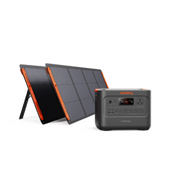







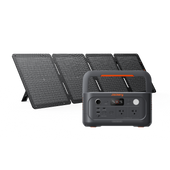




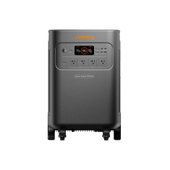

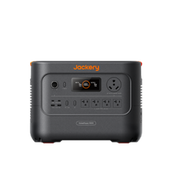
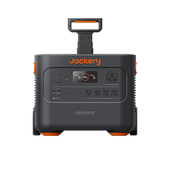
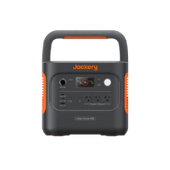


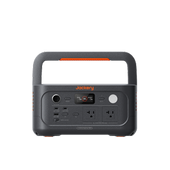






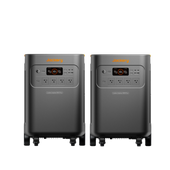
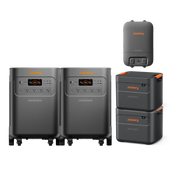


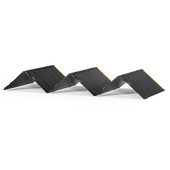


![[Add - on] Jackery Manual Transfer Switch for Explorer 5000 Plus - Jackery](http://www.jackery.com/cdn/shop/files/add-on-jackery-manual-transfer-switch-for-explorer-5000-plus-9017324.png?v=1754016782&width=170)







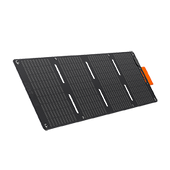





















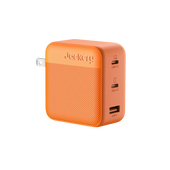
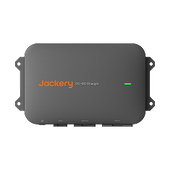
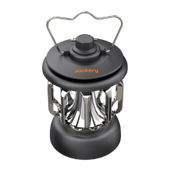












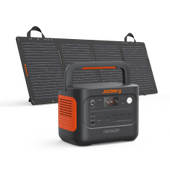








































![What Is The Average Electric Bill in San Diego [2025]](http://www.jackery.com/cdn/shop/articles/what-is-the-average-electric-bill-in-san-diego-2025-6522010.jpg?v=1762240917)







Leave a comment